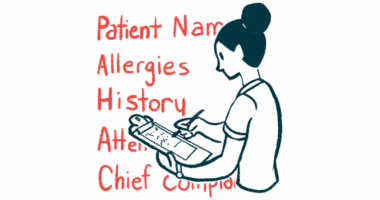ATYR1923 Found Safe, Effective for Pulmonary Sarcoidosis Patients

aTyr Pharma’s experimental therapy ATYR1923 safely and effectively improves lung function and reduces symptoms in adults with pulmonary sarcoidosis, while lowering the need for oral corticosteroids, top-line data from a Phase 1b/2a clinical trial show.
Notably, while all three tested therapy doses were well-tolerated, greater clinically meaningful improvements were observed with the higher dose, 5 mg/kg, according to researchers.
“We are delighted by the results of this study, which provide the first clinical proof-of-concept for ATYR1923, as well as validation for our tRNA synthetase biology platform and Neuropilin-2 as a target,” Sanjay S. Shukla, MD, aTyr’s president and CEO, said in a press release.
“The consistency in dose response and clinically meaningful benefit observed, along with ATYR1923’s favorable safety and tolerability profile, give us great confidence that ATYR1923 could be a transformative, disease modifying therapy for pulmonary sarcoidosis patients,” Shukla said.
Based on the trial’s promising findings, aTyr plans to meet with the U.S. Food and Drug Administration to discuss these data and the best path toward ATYR1923’s approval for pulmonary sarcoidosis, according to Shukla.
Shukla said the company also expects to launch a larger trial next year to support a future submission of a regulatory application seeking the therapy’s approval.
Robert Baughman, MD, professor of medicine and pulmonologist at the University of Cincinnati Medical Center, in Ohio, said he was “very impressed” by the aTyr study, calling it one of the best he had seen conducted in sarcoidosis — “a patient population that is highly underserved by current treatment options.”
“Importantly,” Baughman said, “ATYR1923 demonstrated an improvement in several indicators of quality of life, a high priority for patients, by a much larger margin than I would expect in a trial of this size and duration.”
Sarcoidosis is an inflammatory disease that can lead to the formation of small abnormal lumps or nodules — called granulomas — in virtually any organ in the body, but most often in the lungs, which then is classified as pulmonary sarcoidosis.
Administered directly into the bloodstream (intravenously), ATYR1923 is an immunomodulatory molecule designed to bind neuropilin-2, a protein located at the surface of immune cells. Neuropilin-2 is involved in inflammation and granuloma formation in lung sarcoidosis.
Preclinical studies have shown that ATYR1923 reduces the levels of pro-inflammatory and pro-scarring molecules, and significantly lessens inflammation-dependent scarring.
As such, the therapy is expected to ease symptoms and improve lung function in people living with pulmonary sarcoidosis.
Completed in July, the Phase 1b/2a trial (NCT03824392) evaluated ATYR1923’s safety, tolerability, and preliminary effectiveness in 37 adults living with a pulmonary sarcoidosis diagnosis for at least six months.
The trial also assessed the therapy’s pharmacokinetics, or its movement into, through, and out of the body, and its immunogenicity, which concerns its ability to provoke an unwanted immune response.
Key exploratory efficacy goals included changes in corticosteroid use, lung function, clinical symptoms, and levels of inflammatory biomarkers.
Lung function was assessed through forced vital capacity (FVC), or how much air can be forcibly exhaled from the lungs after taking a deep breath.
Participants were recruited at 15 sites across the U.S. for the 24-week (nearly six-month) study. Each was randomly assigned to receive an into-the-vein infusion of either one of three doses — 1, 3, or 5 mg/kg — of ATYR1923 or a placebo.
Consistent with previous interim data, the final results showed that all three doses of the therapy were generally safe and well-tolerated, with no reports of treatment-related serious adverse events and no signs of unwanted immune responses. This meant that the trial met its main goal.
In addition, ATYR1923 resulted in a dose-dependent response on key efficacy goals, compared with a placebo.
Patients given the therapy’s high dose (5 mg/kg) reduced their corticosteroid use by 58% from the study’s start — results 22% greater than those achieved by patients receiving a placebo.
Notably, 33% of participants in this high-dose group became corticosteroid-free, while no patient in the other groups was able to achieve and sustain that state.
Also, relative to the placebo, the high dose of ATYR1923 led to a 3.3% improvement in FVC, which is considered clinically meaningful. Clinically meaningful reductions over placebo also were observed for shortness of breath, cough, and fatigue, as well as for lung and general health. These assessments came from the use of the King’s Sarcoidosis Questionnaire.
ATYR1923-treated patients also showed dose-dependent reductions in key inflammatory and sarcoidosis biomarkers, compared with those given a placebo, with the greatest drops being observed in the high-dose group.
Notably, while PET-CT scan assessments over the trial were initially planned to provide a better visualization of active sarcoidosis, this data was incomplete, mainly due to operational issues associated with the COVID-19 pandemic.
The trial, sponsored by aTyr Pharma, was conducted in partnership with the Foundation for Sarcoidosis Research.
“The dose response and consistent results across almost every endpoint are remarkable findings, and as good as could be expected in this small study,” said Daniel Culver, chair of the department of pulmonary medicine and director of diffuse parenchymal lung disease at the Cleveland Clinic.
“The ability to taper patients off steroids while controlling disease symptoms in the ATYR1923 treatment groups is particularly compelling and supports advancement of ATYR1923 into the next phase of development,” Culver added.
aTyr hosted a conference call and webcast discussing the trial’s results that can be accessed here.








